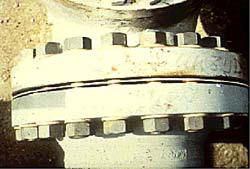|
Galvanic Corrosion
 Galvanic corrosion
occurs when a metal or alloy is electrically coupled to a
different metal alloy. The most common type of galvanic
corrosion in a boiler system is caused by the contact of
dissimilar metals, such as iron and copper. This differential
cells can also be formed when deposits are present. Anything
that results in a difference in electrical potential at discrete
surface locations can cause a galvanic reaction, including:
scratches in a metal surface, differential stresses in a metal,
differences in temperature, conductive deposits. Galvanic corrosion
occurs when a metal or alloy is electrically coupled to a
different metal alloy. The most common type of galvanic
corrosion in a boiler system is caused by the contact of
dissimilar metals, such as iron and copper. This differential
cells can also be formed when deposits are present. Anything
that results in a difference in electrical potential at discrete
surface locations can cause a galvanic reaction, including:
scratches in a metal surface, differential stresses in a metal,
differences in temperature, conductive deposits.
Pitting of boiler tube banks has been encountered due to
metallic copper deposits. Dissolved copper may be plated out on
freshly cleaned surfaces, establishing anodic corrosion areas
and forming pits.
This process is illustrated by the following reactions.
Using hydrochloric acid as the cleaning solvent, magnetite is
dissolved and yields an acid solution containing both ferrous
(Fe2+) and ferric (Fe3+) chloride. The
latter are very corrosive to steel and copper.
Fe3O4
+ 8 HCl > FeCl2 + 2 FeCl3 + 4H2O
Metallic or elemental copper in boiler deposits is dissolved in
the hydrochloric acid solution by the following reaction:
FeCl3 + Cu > CuCl + FeCl2
Once cuprous chloride is in solution, it is immediately
redeposited as metallic copper on the steel surface according to
the following reaction:
2CuCl + Fe > FeCl2 + 2 Cu
Thus, hydrochloric acid cleaning can cause galvanic corrosion. A
complexing agent is added to prevent the copper from
redepositing on the steel surface. The following chemical
reaction results:
FeCl3 + Cu + Complexing agent > FeCl2
+ CuCl
This can take place as
a separate step or during acid cleaning. Both iron and copper
are removed from the boiler, and the boiler surface can then be
passivated.
|



